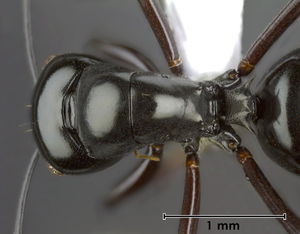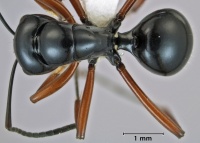Polyrhachis acuminata
| Polyrhachis acuminata | |
|---|---|

| |
| Scientific classification | |
| Kingdom: | Animalia |
| Phylum: | Arthropoda |
| Class: | Insecta |
| Order: | Hymenoptera |
| Family: | Formicidae |
| Subfamily: | Formicinae |
| Tribe: | Camponotini |
| Genus: | Polyrhachis |
| Subgenus: | Cyrtomyrma |
| Species: | P. acuminata |
| Binomial name | |
| Polyrhachis acuminata Kohout, 2007 | |
Nothing is known about the biology of Polyrhachis acuminata.
Identification
Kohout (2007) - Polyrhachis acuminata is very similar to Polyrhachis danum and Polyrhachis lepida, both also known from Sabah. All three species arc distinctly bicoloured with the head, mesosoma, petiole and gaster black and most of the legs bright red or reddish-brown. They have a rather similar lateral mesosomal outline, except that the propodeal declivity is virtually vertical in P. damon and P. lepida, while it is oblique in P. acuminata. Polyrhachis acuminata is also distinguished by its rudimentary propodeal spines that are completely absent in P. danum or indicated only as barely visible tubercles in some P. lepida specimens. The mesosomal sculpturation is uniformly finely shagreened in P. damon, while the sides of the mesosoma are wrinkled in P. acuminata and distinctly reticulate-rugose in P. lepida. However, the main character that distinguishes the three species is the configuration of petiolar spines. In P. damon, all the petiolar spines arc reduced to minute denticles, while in P. acuminata and P. lepida the dorsal pair arc wide-based and toothlike and the lateral spines arc long and slender. In P. acuminata the lateral spines arc lip to four times as long as their basal widths, while they are only twice as long or shorter in P. lepida. The species also differ in their relative sizes, with P. lepida the smallest and P. danum the largest (HL 1.40-1.50 in P. lepida, 1.59-1.62 in P. acuminata and 1.65-1.87 in P. danum).
Keys including this Species
Distribution
Distribution based on Regional Taxon Lists
Indo-Australian Region: Borneo (type locality), Indonesia, Malaysia.
Distribution based on AntMaps
Distribution based on AntWeb specimens
Check data from AntWeb
Countries Occupied
| Number of countries occupied by this species based on AntWiki Regional Taxon Lists. In general, fewer countries occupied indicates a narrower range, while more countries indicates a more widespread species. |

|
Estimated Abundance
| Relative abundance based on number of AntMaps records per species (this species within the purple bar). Fewer records (to the left) indicates a less abundant/encountered species while more records (to the right) indicates more abundant/encountered species. |

|
Biology
Castes
Worker
    
| |
| . | |
Nomenclature
The following information is derived from Barry Bolton's Online Catalogue of the Ants of the World.
- acuminata. Polyrhachis acuminata Kohout, 2007d: 116, figs. 1, 2 (w.) BORNEO.
Unless otherwise noted the text for the remainder of this section is reported from the publication that includes the original description.
Description
Worker
(holotype cited first): TL c. 6.55, 6.75; HL 1.59, 1.62; HW 1.50, 1.53; CI 94, 94; SL 1.96, 2.03; SI 131, 133; PW 1.18, 1.22; MTL 2.34, 2.37 (2 measured). Mandibles with 5 teeth, apical tooth longest, other teeth subequal in length. Anterior clypical margin obtusely truncate with shallow median notch. Clypeus in profile convex with shallow depression behind anterior margin and moderately impressed basal margin. Frontal triangle indistinct. Frontal carinae sinuate with weakly raised margins; central area shallowly concave with shallowly impressed frontal furrow. Sides of head in front of eyes converging towards mandibular bases in weakly convex line; behind eyes sides rounding into convex occipital margin. Eyes moderately convex, in full face view only marginally breaking lateral cephalic outline. Ocelli lacking. Pronotum in dorsal view with humeri widely rounded, with greatest pronotal width just before mid-length of segment. Mesosoma in profile moderately convex, with promesonotal suture distinctly impressed; melanotal groove lacking dorsally, weakly indicated laterally. Propodeal dorsum with indication of rudimentary propodeal spines; rounding into relatively short, oblique declivity. Petiole with dorsal spines reduced to short, blunt, wide-based teeth; lateral spines up to four times as long as their basal width, slender and acute. Subpetiolar process relatively long. angular anteriorly, narrowly rounded posteriorly. Anterior face of first gastral segment in lateral view lower than full height of petiole, very weakly concave at base, narrowly rounding onto dorsum of segment.
Mandibles finely longitudinally striate with numerous piliferous pits; sculpture becoming rather smooth and polished towards bases. Head, mesosoma, petiole and gaster very finely shagreened, rather polished with numerous shallow punctures; sculpture becoming somewhat finely wrinkled on meso- and metapleurae. Petiole very finely transversely wrinkled, with sculpture more intensely reticulate- rugose at base.
Mandibles with numerous semierect hairs at masticatory borders. Anterior clypeal margin with several moderately long, anteriorly directed setae and a few short setae lining margin laterally. Two pairs of erect hairs arising near anterior margin and one pair along frontal carinae. Rather long, erect hairs on anterior face of fore coxae; distinctly shorter hairs on posterior face and on ventral surfaces of trochanters. Gaster with medium length, erect hairs lining posterior margins of apical segments, hairs on gastral venter more abundant.
Black, with mandibular masticatory borders, condylae and extreme tips of apical funicular segments reddish-brown. Legs, including trochanters, distinctly red or reddish-brown with proximal ends of tibiae, coxae and tarsi virtually black.
Type Material
Holotype worker, East Malaysia (Sabah): Kinabalu Park, Poring Hot Springs, 06°02'N, 116°43' E, 27.vi.2006, R.J. & E. Kohout acc. 06.5. Paralype: 1 worker, same data as holotype. Holotype in Institute for Tropical Biology and Conservation; paratype in Queensland Museum.
Etymology
From the Latin acuminatus, meaning pointed, in reference to the long, sharply pointed lateral petiolar spines.
References
References based on Global Ant Biodiversity Informatics
- Pfeiffer M.; Mezger, D.; Hosoishi, S.; Bakhtiar, E. Y.; Kohout, R. J. 2011. The Formicidae of Borneo (Insecta: Hymenoptera): a preliminary species list. Asian Myrmecology 4:9-58

